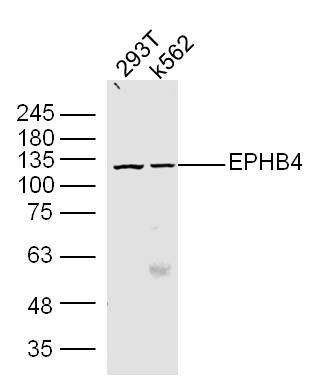
Rabbit Anti-EPHB4 antibody
Eph receptor B4; EPHB4_HUMAN; Ephrin type-B receptor 4; Hepatoma Transmembrane Kinase; HTK; MYK1; TYRO11; Tyrosine-protein kinase receptor HTK; Tyrosine-protein kinase TYRO11.
View History [Clear]
Details
Product Name EPHB4 Chinese Name 酪氨酸蛋白激酶受体B4抗体 Alias Eph receptor B4; EPHB4_HUMAN; Ephrin type-B receptor 4; Hepatoma Transmembrane Kinase; HTK; MYK1; TYRO11; Tyrosine-protein kinase receptor HTK; Tyrosine-protein kinase TYRO11. literatures Research Area Cardiovascular Cell biology Neurobiology Signal transduction Stem cells The cell membrane受体 Immunogen Species Rabbit Clonality Polyclonal React Species Human, (predicted: Mouse, Rat, Dog, Pig, Cow, Horse, Rabbit, Guinea Pig, ) Applications WB=1:500-2000 ELISA=1:5000-10000 IHC-P=1:100-500 (Paraffin sections need antigen repair)
not yet tested in other applications.
optimal dilutions/concentrations should be determined by the end user.Theoretical molecular weight 107kDa Cellular localization The cell membrane Form Liquid Concentration 1mg/ml immunogen KLH conjugated synthetic peptide derived from human Eph receptor B4: 601-700/987 Lsotype IgG Purification affinity purified by Protein A Buffer Solution 0.01M TBS(pH7.4) with 1% BSA, 0.03% Proclin300 and 50% Glycerol. Storage Shipped at 4℃. Store at -20 °C for one year. Avoid repeated freeze/thaw cycles. Attention This product as supplied is intended for research use only, not for use in human, therapeutic or diagnostic applications. PubMed PubMed Product Detail Ephrin receptors and their ligands, the ephrins, mediate numerous developmental processes, particularly in the nervous system. Based on their structures and sequence relationships, ephrins are divided into the ephrin-A (EFNA) class, which are anchored to the membrane by a glycosylphosphatidylinositol linkage, and the ephrin-B (EFNB) class, which are transmembrane proteins. The Eph family of receptors are divided into 2 groups based on the similarity of their extracellular domain sequences and their affinities for binding ephrin-A and ephrin-B ligands. Ephrin receptors make up the largest subgroup of the receptor tyrosine kinase (RTK) family. The protein encoded by this gene binds to ephrin-B2 and plays an essential role in vascular development. [provided by RefSeq, Jul 2008]
Function:
Receptor tyrosine kinase which binds promiscuously transmembrane ephrin-B family ligands residing on adjacent cells, leading to contact-dependent bidirectional signaling into neighboring cells. The signaling pathway downstream of the receptor is referred to as forward signaling while the signaling pathway downstream of the ephrin ligand is referred to as reverse signaling. Together with its cognate ligand/functional ligand EFNB2 plays a central role in heart morphogenesis and angiogenesis through regulation of cell adhesion and cell migration. EPHB4-mediated forward signaling controls cellular repulsion and segregation form EFNB2-expressing cells. Plays also a role in postnatal blood vessel remodeling, morphogenesis and permeability and is thus important in the context of tumor angiogenesis.
Subunit:
Heterotetramer upon binding of the ligand. The heterotetramer is composed of an ephrin dimer and a receptor dimer. Oligomerization is probably required to induce biological responses.
Subcellular Location:
Cell membrane; Single-pass type I membrane protein.
Tissue Specificity:
Abundantly expressed in placenta and in a range of primary tissues and malignant cell lines. Expressed in fetal, but not adult, brain, and in primitive and myeloid, but not lymphoid, hematopoietic cells.
Post-translational modifications:
Phosphorylated; autophosphorylation is stimulated by EFNB2.
Similarity:
Belongs to the protein kinase superfamily. Tyr protein kinase family. Ephrin receptor subfamily.
Contains 2 fibronectin type-III domains.
Contains 1 protein kinase domain.
Contains 1 SAM (sterile alpha motif) domain.
SWISS:
P54760
Gene ID:
2050
Database links:Entrez Gene: 2050 Human
Entrez Gene: 13846 Mouse
Omim: 600011 Human
SwissProt: P54760 Human
SwissProt: P54761 Mouse
Unigene: 437008 Human
Unigene: 34533 Mouse
Product Picture
References (0)
No References
Bought notes(bought amounts latest0)
No one bought this product
User Comment(Total0User Comment Num)
- No comment



 +86 571 56623320
+86 571 56623320
 +86 18668110335
+86 18668110335

